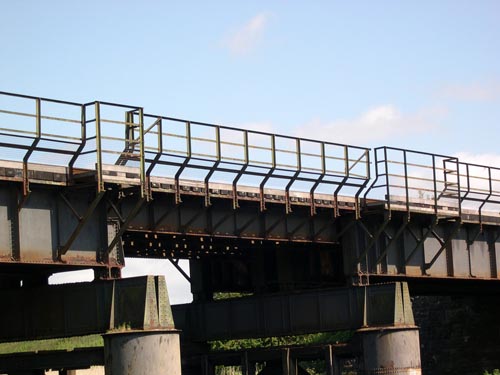|
Three Bridges:
Ottawa Valley
Associated
Railroaders - OVAR, The Interchange, September 2007.Movable, Immovable and Removable! Few people think twice when traveling in a train over a railway bridge but some bridges can take on a life of their own as I found while working on British Rail. A
The operating instructions were clear as to how the bridge was to be raised but the signal box, hidden in the undergrowth, had been closed for some twenty years and had been heavily vandalized. It was amazing how many people it took to raise the bridge. The District Signalling Inspector was there with one of his signalmen and one of my porters to protect the line in both directions. The Ganger was there with his gang to unbolt and rebolt the rails. The District Signal Engineer had a crew on hand to disconnect and reconnect the block telegraph while the District Engineer and his crew were there to perform the hurculean feat. There were so many people that there wasn’t room for all of them on the bridge. The mayoral launch was a rather small affair, so small, in fact, that it would go under the bridge at all states of the tide. This explained why His Worship had been very specific about the time. The launch was late as it had encountered a strong headwind. Nevertheless we raised the bridge about two inches then quickly lowered and secured it safe and sound for another year. Honour was now satisfied on both sides and everybody could go home.An Immovable bridge The bridge overThe work was planned in great detail. The old girders would be lifted out on to a train of empty flat cars then the new girders, each one slightly different because it had to fit precisely into its allotted place, would be brought up and lifted into place. The engineers assured me it would run as smooth as clockwork and I would have my line back in good time on Sunday morning. They removed the old girders quickly according to plan. However, when they came to place the first new girder it wouldn’t fit. There was much head scratching. They tried the second girder and this wouldn’t fit either. The head scratching turned to panic-stricken tearing out of hair.The only thing to be done was to replace the original steel spans because we had a railway to run. It turned out that the new spans had been placed on the flatcars in a specific order and properly marked. However, the operating department, at some point in its journey to A Removable Bridge
This was told me by a signalman over a cup of tea in the Haverfordwest signalbox. It seems so implausible that I think it is a true story. The Whitland to Cardigan line had been abandoned and the rails lifted some time before I came on the scene. British Railways had sold a small steel road overbridge to a scrap dealer who made arrangements with the local police to set up a road diversion on a Monday morning to allow him to remove the structure. Early on the Sunday morning before the work was due to be done, someone walked into the Police Station and explained that the scrap dealer had his men and machines all ready and they could remove the bridge that day. This would have created less disruption to traffic and so a constable went out and arranged the road diversion a day early. The bridge was taken down with helpful assistance from the local constabulary. The next morning the legitimate scrap dealer arrived to take down the bridge! We never did find out who took it – probably the same people who removed fourteen miles of copper signal wire from the Pembroke branch one Sunday when there were no trains |

